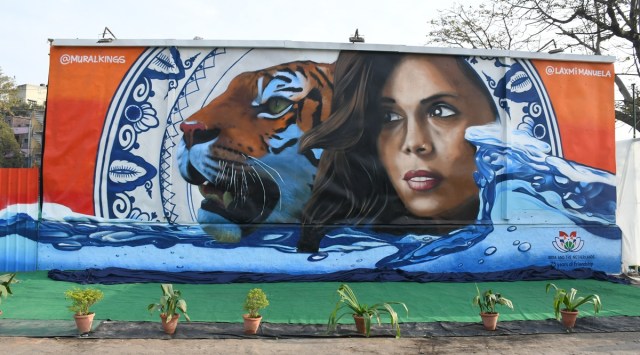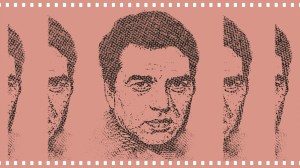Stay updated with the latest - Click here to follow us on Instagram
Mural in Delhi’s Nizamuddin honours 75 years of Dutch-India relations
Dutch street artists Roelof van Schierbeek and Laxmi Manuela were invited to create large mural paintings showing Dutch-India connections in Mumbai, Bengaluru and New Delhi
 Work on the mural began when a pioneering public art enterprise, Delhi Street Art, invited two Dutch street artists, Roelof van Schierbeek and Laxmi Manuela, to create large mural paintings showing Dutch-India connections in Mumbai, Bengaluru and New Delhi. (Express Photo)
Work on the mural began when a pioneering public art enterprise, Delhi Street Art, invited two Dutch street artists, Roelof van Schierbeek and Laxmi Manuela, to create large mural paintings showing Dutch-India connections in Mumbai, Bengaluru and New Delhi. (Express Photo) The Embassy of the Kingdom of the Netherlands on Tuesday unveiled a mural in Delhi’s Nizamuddin area as part of its multi-city art initiative. Created by Dutch and New Delhi-based artists, the mural signifies and celebrates 75 years of bilateral relations between India and the Netherlands.
Minister of State for External Affairs and Culture of India Meenakshi Lekhi, Secretary-General, Ministry of Foreign Affairs of the Netherlands Paul Huijts and Ambassador of the Kingdom of the Netherlands to India, Nepal and Bhutan, Marten van den Berg, inaugurated the mural.
“The cultural connection and cooperation between India and the Netherlands have a longstanding, glorious history, and this year marks a significant milestone as the maitri (friendship) between the two countries completes 75 years. Celebrating creativity and diversity, this inspiring mural art project brought together art and artists from two different parts of the world, enhancing the people-to-people connection between India and the Netherlands, and solidifying the foundation for rich cultural exchange between the nations. We hope the public will enjoy and appreciate this addition to Delhi’s vibrant public art,” said Huijts.
Work on the mural began when a pioneering public art enterprise, Delhi Street Art, invited two Dutch street artists, Roelof van Schierbeek and Laxmi Manuela, to create large mural paintings showing Dutch-India connections in Mumbai, Bengaluru and New Delhi. The mural in Bengaluru showcases the lion — formerly the national animal of India and symbolic of strength in the Dutch Royal Family — at a prominent spot in Bengaluru. The mural painting in Mumbai visualises the contrast between Indian and Dutch culture. A striking image of an Indian woman, resplendent in her traditional jewellery, shows her dreaming about visiting the Netherlands one day.
In the Delhi mural, Manuela and Schierbeek painted an Indian woman, accompanied by a tiger. Explaining the inspiration behind the mural, Schierbeek said, “The woman draws strength from the tiger, which is also the national animal of India. The two figures represent India in all its splendour. We painted water at the bottom part of the mural to represent the bilateral water management between the two countries,” said Schierbeek.
Talking about the woman in the mural, Manuela said, “That woman is my self-portrait. When I started making oil paintings in 2016, I made self-portraits without any reason. Later I realised it was a way of analysing myself and my life story in paintings. In my paintings, I like to talk about subjects that are taboo in Hindu culture and other cultures — sexuality and menstruation. When we were discussing the designs for this mural, we were thinking of women’s empowerment. My self-portrait is just a symbol for a woman.”
The background has motifs denoting the famous Delfts Blue ceramics found in the Netherlands, while the artists painted the rest of the backdrop in orange as it is a common colour in the flags of both countries.
Manuela is a self-taught artist based in Rotterdam, the Netherlands. Her work is often associated with taboo-breaking themes and the empowerment of women. Mural Kings is a street art organisation started by Schierbeek that is based in the Netherlands with more than 25 years of experience in the field of street art and murals.







